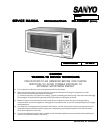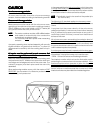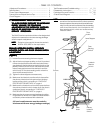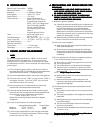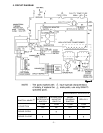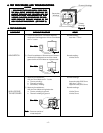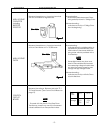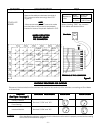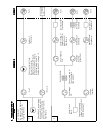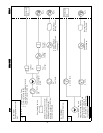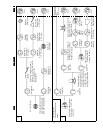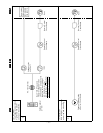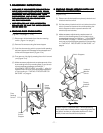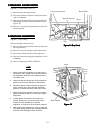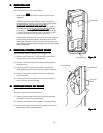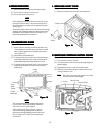
2.2.
2.2.
2.
SPECIFICASPECIFICA
SPECIFICASPECIFICA
SPECIFICA
TIONSTIONS
TIONSTIONS
TIONS
Rated Power Consumption .. 1480W.
Microwave Output ................1050W.
Frequency .............................2,450MHz±50MHz.
Power Supply ........................120V±12V, 60Hz.
Rated Current ....................... 12.9 Amp.
Safety Devices .....................Thermal Fuse open at
332°F (167°C) for Cavity.
Thermal Protector open at
252°F (122°C) for Magnetron.
Fuse (Cartridge Type 20A)
Primary Interlock Switch,
Door Sensing Switch and
Relay 2.
Interlock Monitor Switch.
Timer .....................................Electronic Digital, up to
99 min. 99 sec.
Overall Dimensions ................20
5
/
8
”(W) x 16
1
/
2
”(D) x 11
3
/
8
”(H)
Oven Cavity Size .................. 13
3
/
4
”(W) x 14
5
/
8
”(D) x 8
1
/
2
”(H)
Turn Table Diameter..............10
7
/
8
”
Effective Capacity of
Oven Cavity ..........................1.1 Cubic Feet.
Net Weight ...........................Approx. 34.5 Lbs.
3.3.
3.3.
3.
POWER OUTPUT MEASUREMENTPOWER OUTPUT MEASUREMENT
POWER OUTPUT MEASUREMENTPOWER OUTPUT MEASUREMENT
POWER OUTPUT MEASUREMENT
NOTENOTE
NOTENOTE
NOTE
The power output specification, 1050W. on this model is
measured with IEC measurement. The power output is
measured with two (2) liters water is equivalent to 1050W.
in measurement with IEC, when measured with the following
power output.
(1) Fill two beakers (glass or plastic) with each one liter of
tap water (about 20°C) and measure the water temperature.
(Use a thermometer with a 1/10 degree gauge).
(2) Place the beakers side by side in the center of the glass tray.
(3) Close the door, set the “TIME” for two minutes. (“200” in
the display window). Touch the “START” key and heat
the water exactly for two minutes.
(4) Take the beakers out, immediately stir the water and
measure the water temperature respectively.
(5) Calculate the temperature rise of water in each beaker.
Then calculate the average value of two temperature rises.
Output power can be calculated by the equation :
Power Output (W) = 70 x ∆t
Where ∆t is an average temperature rise in degrees
Centigrade.
(6) Power Output shall be in the following range :
Average Temperature Rise Power Output
Minimum 19.6°F (10.9°C) 763W
Maximum 20.0°F (14.0°C) 980W
(7) Power Output is affected by the line voltage under load.
For correct Power Output measurement, the line voltage
under load must be 120±1 volts.
4.4.
4.4.
4.
PRECAUTIONS AND REPPRECAUTIONS AND REP
PRECAUTIONS AND REPPRECAUTIONS AND REP
PRECAUTIONS AND REP
AIR SERAIR SER
AIR SERAIR SER
AIR SER
VICE TIPSVICE TIPS
VICE TIPSVICE TIPS
VICE TIPS
PRELIMINARPRELIMINAR
PRELIMINARPRELIMINAR
PRELIMINAR
YY
YY
Y
A.A.
A.A.
A.
SINCE NEARLSINCE NEARL
SINCE NEARLSINCE NEARL
SINCE NEARL
Y 2,000 VOLY 2,000 VOL
Y 2,000 VOLY 2,000 VOL
Y 2,000 VOL
TS EXISTS IN SOME CIR-TS EXISTS IN SOME CIR-
TS EXISTS IN SOME CIR-TS EXISTS IN SOME CIR-
TS EXISTS IN SOME CIR-
CUITS OF THIS MICROWCUITS OF THIS MICROW
CUITS OF THIS MICROWCUITS OF THIS MICROW
CUITS OF THIS MICROW
AA
AA
A
VE OVEN, REPVE OVEN, REP
VE OVEN, REPVE OVEN, REP
VE OVEN, REP
AIRS SHOULDAIRS SHOULD
AIRS SHOULDAIRS SHOULD
AIRS SHOULD
BE CARRIED OUT WITH GREABE CARRIED OUT WITH GREA
BE CARRIED OUT WITH GREABE CARRIED OUT WITH GREA
BE CARRIED OUT WITH GREA
T CARE.T CARE.
T CARE.T CARE.
T CARE.
B.B.
B.B.
B.
TO ATO A
TO ATO A
TO A
VOID POSSIBLE EXPOSURE TO MICROWVOID POSSIBLE EXPOSURE TO MICROW
VOID POSSIBLE EXPOSURE TO MICROWVOID POSSIBLE EXPOSURE TO MICROW
VOID POSSIBLE EXPOSURE TO MICROW
AA
AA
A
VEVE
VEVE
VE
ENERGY LEAKAGE, THE FOLLOWING PRECAUTIONSENERGY LEAKAGE, THE FOLLOWING PRECAUTIONS
ENERGY LEAKAGE, THE FOLLOWING PRECAUTIONSENERGY LEAKAGE, THE FOLLOWING PRECAUTIONS
ENERGY LEAKAGE, THE FOLLOWING PRECAUTIONS
MUST BE TMUST BE T
MUST BE TMUST BE T
MUST BE T
AKEN BEFORE SERAKEN BEFORE SER
AKEN BEFORE SERAKEN BEFORE SER
AKEN BEFORE SER
VICING.VICING.
VICING.VICING.
VICING.
(1) Before the power is applied :
(a) Open and close door several times to make sure the
primary interlock switch, the interlock monitor switch
and the door sensing switch operate properly.
(Listen for the clicking sound from the switches).
Make sure the interlock monitor switch closes after
the primary interlock switch is opens when the door
is opened. (See pages 1 and 6).
(b) Make sure the perforated screen and the choke die-
lectric of the door are correctly mounted.
(2) After the power is applied :
(a) Open and close the door to see if the interlock mech-
anism operates properly.
(b) Check microwave energy leakage with a leakage
detector and confirm the energy leakage should be
no greater than 4mW/cm
2
to allow for measurement
uncertainty.
(3) Do not operate the unit until it is completely repaired,
if any of the following conditions exists :
(a) Door does not close firmly against the cavity front.
(b) The hinge is broken.
(c) The choke dielectric or the door seal is damaged.
(d) The door is bent or warped, or there is any other
visible damage to the oven that may cause microwave
energy leakage.
NOTE :
Always keep the seal clean.Always keep the seal clean.
Always keep the seal clean.Always keep the seal clean.
Always keep the seal clean.
(e) Make sure that there are no defective parts in the
interlock mechanism.
(f) Make sure there are no defective parts in the
microwave generating and transmission assembly.
(especially waveguide).
(4) The following items should be checked after the unit
is repaired :
(a) The interlock monitor switch is connected correctly
and firmly.
(b) The magnetron gasket on the magnetron is properly
positioned.
(c) Waveguide and oven cavity are intact (no leakage of
microwave energy).
(d) The door can be properly closed and the safety
switches work properly.
(e) The oven must be stopped when the door is opened
or the time is up.
The oven must not be operated with any of the aboveThe oven must not be operated with any of the above
The oven must not be operated with any of the aboveThe oven must not be operated with any of the above
The oven must not be operated with any of the above
components rcomponents r
components rcomponents r
components r
emoved or bypassed.emoved or bypassed.
emoved or bypassed.emoved or bypassed.
emoved or bypassed.
- 2 -



